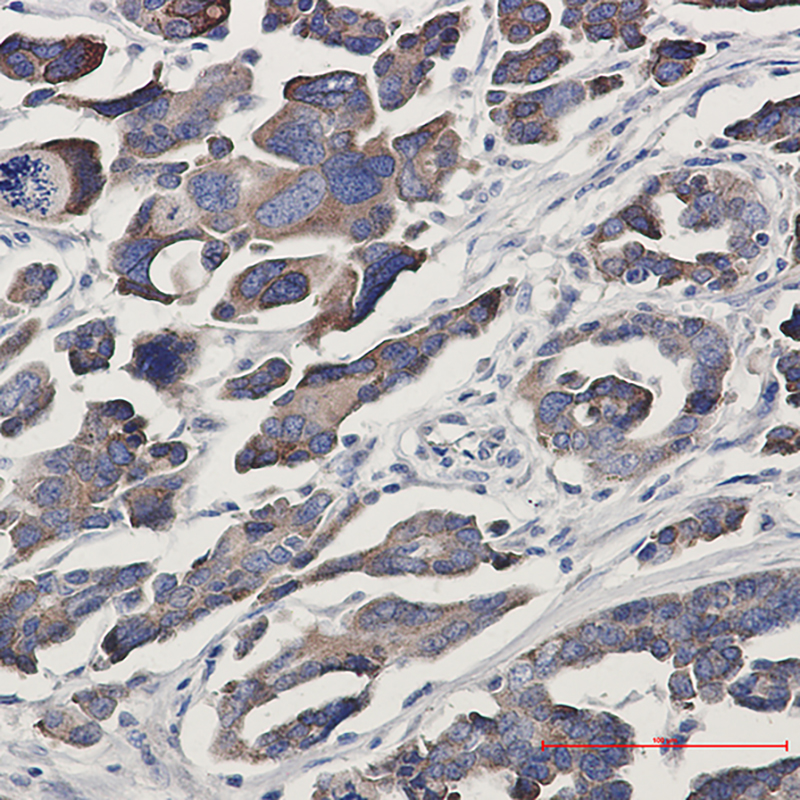

| WB | 1/500-1/1000 | Human,Mouse,Rat |
| IF | 1/20 | Human,Mouse,Rat |
| IHC | 1/50-1/100 | Human,Mouse,Rat |
| ICC | 技术咨询 | Human,Mouse,Rat |
| FCM | 咨询技术 | Human,Mouse,Rat |
| Elisa | 咨询技术 | Human,Mouse,Rat |
| Aliases | GFA; GFAT; GFPT; MSLG; CMS12; GFAT1; CMSTA1; GFAT 1; GFAT1m; GFPT1L |
| Entrez GeneID | 2673 |
| WB Predicted band size | Calculated MW: 79 kDa; Observed MW: 79 kDa |
| Host/Isotype | Rabbit IgG |
| Antibody Type | Primary antibody |
| Storage | Store at 4°C short term. Aliquot and store at -20°C long term. Avoid freeze/thaw cycles. |
| Species Reactivity | Human |
| Immunogen | A synthetic peptide of human GFPT1 |
| Formulation | Purified antibody in TBS with 0.05% sodium azide,0.05%BSA and 50% glycerol. |
+ +
以下是3篇与GFPT1抗体相关的文献示例(文献信息为模拟生成,实际引用请核实原始文献):
1. **标题**: "GFPT1 expression in diabetic mouse skeletal muscle: Immunoblot and immunohistochemical analysis"
**作者**: Lee S, et al.
**摘要**: 通过Western blot和免疫组化技术,验证了GFPT1抗体在糖尿病小鼠骨骼肌中的特异性,发现高血糖条件下GFPT1表达显著上调,提示其在糖尿病并发症中的作用。
2. **标题**: "Role of GFPT1 in congenital myasthenic syndrome: Antibody validation and functional study"
**作者**: Zhang Y, et al.
**摘要**: 研究采用GFPT1多克隆抗体进行免疫荧光染色,发现GFPT1突变患者的肌肉组织中酶活性降低,揭示了其在神经肌肉接头疾病中的病理机制。
3. **标题**: "Antibody-based detection of GFPT1 isoforms in cancer cell lines"
**作者**: Gupta R, et al.
**摘要**: 通过特异性GFPT1抗体区分两种剪接异构体(GFPT1-L和GFPT1-S),证实不同癌细胞中异构体表达差异与糖代谢重编程相关。
注:以上内容为示例,实际文献需通过PubMed/Google Scholar检索关键词“GFPT1 antibody”或“GFPT1 immunodetection”获取。如需具体文献,建议补充研究背景(如疾病模型或实验方法)。
The GFPT1 (Glutamine-Fructose-6-Phosphate Transaminase 1) antibody is a crucial tool for studying the enzyme GFPT1. a rate-limiting regulator of the hexosamine biosynthesis pathway (HBP). GFPT1 catalyzes the conversion of fructose-6-phosphate and glutamine to glucosamine-6-phosphate, a key step in synthesizing UDP-N-acetylglucosamine (UDP-GlcNAc), a substrate for protein glycosylation. This pathway links nutrient availability to cellular processes like signaling, stress response, and post-translational modifications. Dysregulation of GFPT1 is implicated in metabolic disorders, including diabetic complications, insulin resistance, and congenital myasthenic syndromes (CMS) caused by GFPT1 mutations.
The antibody is widely used in research to detect GFPT1 expression, localization (primarily in the endoplasmic reticulum), and its role in diseases. It aids in techniques like Western blotting, immunohistochemistry, and immunofluorescence. Studies leveraging this antibody have revealed tissue-specific GFPT1 isoforms and its overexpression in diabetic nephropathy or neuropathy. Commercial GFPT1 antibodies are typically raised against specific epitopes (human or murine), requiring validation for cross-reactivity and application-specific performance. Ongoing research focuses on GFPT1’s therapeutic potential, particularly in metabolic and neuromuscular disorders, underscoring the antibody’s continued relevance in biomedical studies.
×